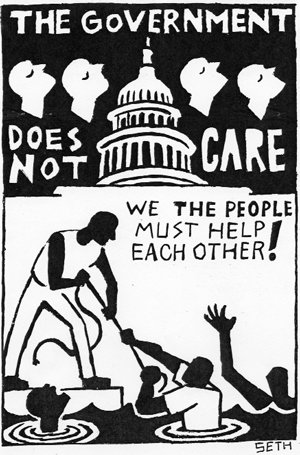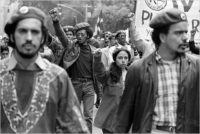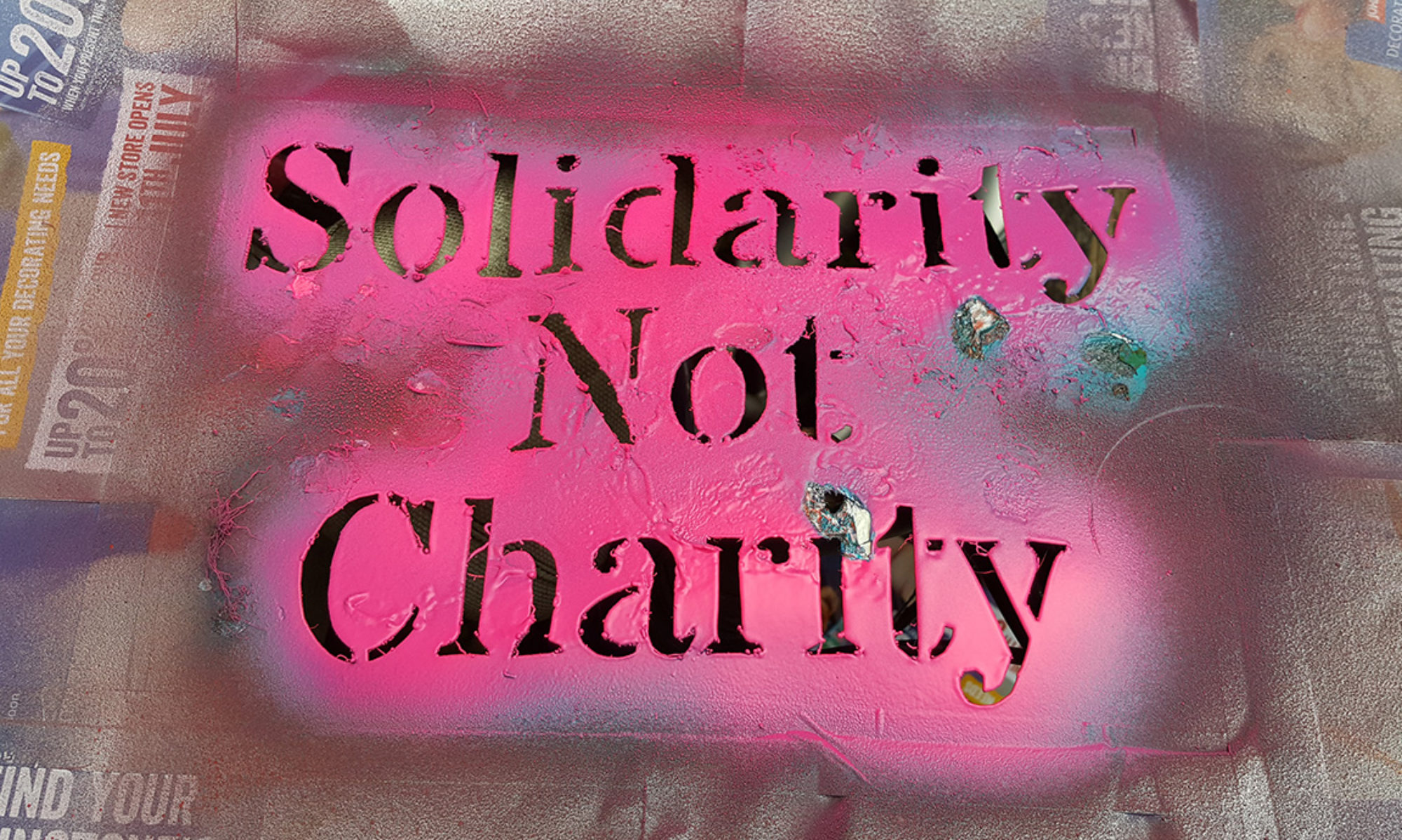What do we mean by “mutual aid”?
Mutual aid is when people get together to meet each other’s basic survival needs with a shared understanding that the systems we live under are not going to meet our needs and we can do it together RIGHT NOW! Mutual aid projects are a form of political participation in which people take responsibility for caring for one another and changing political conditions, not just through symbolic acts or putting pressure on their representatives in government, but by actually building new social relations that are more survivable. Most mutual aid projects are volunteer-based, with people jumping in to participate because they want to change what is going on right now, not wait to convince corporations or politicians to do the right thing. A few critical concepts are inside this:
- “Charity” is a framework that often means rich people giving a little bit to poor people to make themselves look better in the eyes of God or other people. Usually there are lots of strings attached to what they give: e.g., giving only to mothers, only to children, only to sober people, only to people of faith and other “deserving poor” models. This means that charity is often a strategy for controlling poor people. Charity also frames people in need as morally lesser than rich people—as if poverty were the fault of the poor rather than the fault of systems of racism, heteropatriarchy, ableism, land theft and labor exploitation that make some people rich and keep other people poor. Charity looks like generosity from rich people, but actually upholds the systems that make most people poor for the benefit of the few.

Image by Seth Tobocman. - Charity is the frame used for most social services delivery. Most social services blame poor people for poverty, operating on the idea that there is something wrong with people in need—they need to get sober, they need to get “housing-ready,” they need to take parenting classes, they need to work harder. In reality, poverty is a result of capitalism, and people of color and women are the poorest people because of sexism and racism. Social service agencies typically employ middle and upper class people, often with race and educational privilege, and put them in the role of judging, punishing and controlling poor people. Sometimes they put “empowerment” in their name or mission statement, but the power dynamics are usually the old standards.
- In recent decades, charity and social services have been privatized and contracted out to what critics call the Non-Profit Industrial Complex. Non-profits compete for grants from corporations or philanthropists to address social problems or serve poor people. This means that rich people and corporations get to decide what strategies should be funded. They also get to protect their money from taxation if they give it out to non-profits. Non-profits are mostly run by rich white people with graduate degrees, they have steep pay scales in which upper class people and white people get paid more, and the people most effected by the issues they claim to address have no say in what they do or how they work.
Mutual aid projects depart from these norms of charity, social services and non-profitization in several key ways that often include:
- An understanding that it is the system, not the people suffering under it, that creates poverty, crisis, and vulnerability
- Governance/control by people who are most effected (can mean having a membership base of those most effected, or being formed in ways that ensure those providing the aid are from the same group as those giving the aid, or models that allow allies to participate but focus on accountability to those being served)
- Transparency about how they work, any money they use or manage (many mutual aid projects are not funded and are all volunteer run)
- Open meetings and pathways for new people to join and participate
- Political education within the organization to help those working in the project to expand their awareness of experiences that are not their own, to build solidarity, and to make the project supportive and welcoming to marginalized people
- Humility and willingness to accept feedback about how to make the project more useful to the people it serves
- Long-term commitment to provide the aid the project works on
- Connection to and solidarity with other mutual aid projects and other transformative work
- Commitment to dignity and self-determination of people in need or crisis
- Consensus-based decision making rather than majority rule
Readings & Videos
Examples of Mutual Aid Work and Descriptions of Mutual Aid
- 8 Black Panther Party Programs that Were More Empowering Than Federal Government Programs, article by Nick Chiles illustrating some of the BPP’s radical mutual aid work.
- The Lincoln Hospital Offensive, article about when the Young Lords took over Lincoln Hospital in 1970 to expose racism and abuse, and set up mutual aid
 programs that changed the hospital and the community.
programs that changed the hospital and the community. - Mutual Aid entry on Indigene Community site, discussing mutual aid in relation to the Constitution of the People of the Longhouse confederacy six nations Haudenosaunee (Rotinosaunee) and Kropotkin’s writing.
- Mutual Benefit entry in The Making of African American Identity, Vol. 1 1500-1865, describing the role and work of mutual aid societies formed by free black people.
- Interdependency, article by Mia Mingus, 2008
- Now Is the Time For Nobodies, interview with Dean Spade about the need for mutual aid projects in the Trump era.
- Here is an outline for a training about the relationship between direct survival support work and transformative social change, inspired by insights in Harsha Walia’s book Undoing Border Imperialism.
- Charity, Mutual Aid and Class Struggle, article by Phil Dickens 2010
- What is Mutual Aid? 6 minute video addressing the concept as key to anarchist thought, 2016
Critique of Non-Profits, Charity and Social Services
- The Revolution Will Not Be Funded is a very useful anthology about the problems with the non-profit industrial complex and how groups have developed some alternative approaches. You can read the introduction here.
- From the Bottom Up: Strategies and Practices from Membership-Based Organizations is a study done by the Sylvia Rivera Law Project of nine organizations, looking at how they are implementing the critiques of nonprofitization and social services in their work. It has concrete ideas for building organizations that are accountable to the people they serve.
- Regulating the Poor: The Functions of Public Welfare is a classic book about why charity was developed to help control and manage poor and displaced people, stigmatize poverty, and keep labor cheap for the owning class. It’s a pretty academic book but there are summaries available online.
- The NPIC and Trans Resistance is an article about the problems with the Nonprofit Industrial Complex in the context of queer and trans resistance. It discusses why the Sylvia Rivera Law Project became a collective in order to do its work providing free legal help to trans and gender nonconforming people.
- This series of videos explores how nonprofitization impacted queer/trans movements in terms of priorities, strategies and leadership, and what some alternatives are:
Queer Dreams Part 1: What are We Fighting For? from BCRW Videos on Vimeo.
Queer Dreams and Nonprofit Blues Part 2: How Do Rich People Control Our Movements? from BCRW Videos on Vimeo.
Queer Dreams and Nonprofit Blues Part 3: The Nonprofit Hamster Wheel from BCRW Videos on Vimeo.
Queer Dreams and Nonprofit Blues Part 4: Who’s in Charge? from BCRW Videos on Vimeo.
Queer Dreams and Nonprofit Blues Part 5: Basebuilding from BCRW Videos on Vimeo.
